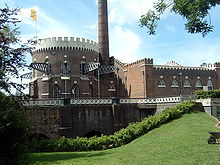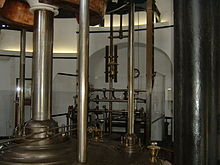De Cruquius pumping station
The De Cruquius pumping station ( Dutch Gemaal De Cruquius ) from 1849 is one of three historic steam pumping stations that drained the Haarlemmermeer polder in the Dutch province of North Holland . The pumping station and the village in which it stands were named after Nicolaus Samuelis Cruquius , a famous Dutch hydraulic engineer. It was in operation until 1933, from 1934 it was set up as a museum. The pumping station was declared a Rijksmonument .
The other two pumping stations De Lijnde and De Leeghwater have been modernized.
museum
The museum shows in detail the centuries-old struggle against water. Various models of windmills that were used to pump water are shown in the exhibition. In addition, many machines and equipment related to hydraulic engineering , a large landscape diorama and drawings.
The original steam-driven pump is still preserved and it can also be put into operation. However, it has been powered hydraulically since 2002. In the center of the round machine house is the huge steam cylinder, with a diameter of 3.66 meters, the largest ever built. It drives eight lever arms, each weighing 10 tons, which reach out through the windows. Eight pumps are attached to this in the ring channel, each of which delivers 8,000 liters of water with one stroke. With an output of five strokes per minute, 320 m³ of water per minute were pumped out of the Haarlemmermeer .
The pumping station is part of the European Route of Industrial Heritage .
Web links
- Website of the Haarlemmermeer Museum De Cruquius (Dutch, English)
Coordinates: 52 ° 20 ′ 16.8 ″ N , 4 ° 38 ′ 17.6 ″ E

